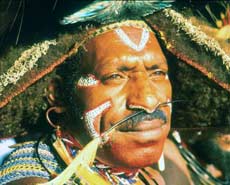Papua New Guinea
Background
New Guinea is the tallest and second largest island in the world, and one of the few places on earth that can still inspire fresh awe and true trepidation in would-be travellers.
The country's mystique is enhanced by the fact that large sections of the island have never been charted by Westerners, and furthermore by the stunning trick of time meaning that some of its inhabitants had seen the aeroplane before they emerged from the Stone Age!
The highland regions have undergone a super-accelerated rate of change, going from first contact with the outside world to silicon chip technology in 70 years.
The island is currently divided between independent Papua New Guinea (PNG) to the east and Irian Jaya (Indonesia) to the west. New Guinea was born of a titanic collision between Asia and Australia. Its extraordinary landscape sweeps up from steaming coastal swamps, through pristine rainforests and seemingly impenetrable mountain ranges, up to the frozen wilderness of the Carstenz Pyramid with its equatorial glaciers.
New Guinea is a bird-watcher's paradise with over 700 species, including 38 of the 43 known varieties of Birds Of Paradise. Strange forms of animal life have evolved, such as the Long Beaked Echidna and gigantic lizards. In the forests there are more types of bat than anywhere else, as well as around 5,000 species of moth and butterfly, some the size of plates.
In human terms New Guinea supports the greatest linguistic diversity on earth. The island is home to hundreds of tribal groups -- including some of the most remote communities in the world -- speaking a staggering 1,000 dialects. Among the most noticeable are the Dani people of Irian Jaya, with their decorative penis gourds, and the Huli "wigmen" of PNG whose elaborate head-dresses are unforgettable.
Highlights
Papua New Guinea occupies the eastern half of the rugged tropical island of New Guinea (which it shares with the Indonesian territory of Irian Jaya) as well as numerous smaller islands and atolls in the Pacific.
The central part of the island rises into a wide ridge of mountains known as the Highlands, a territory that is so densely forested and topographically foreboding that the island's local peoples remained isolated from each other for millennia.
The coastline is liberally endowed with spectacular coral reefs, giving the country an international reputation for scuba diving.
The smaller island groups of Papua New Guinea include the Bismarck Archipelago, New Britain, New Ireland and the North Solomons. Some of these islands are volcanic, with dramatic mountain ranges, and all are relatively undeveloped.
Nearly 85 percent of the main island is carpeted with tropical rain forest, containing vegetation that is a combination of Asian and Australian species.
The country is also home to an impressive variety of exotic birds, including virtually all of the known species of "birds of paradise," and it is blessed with more kinds of orchids than any other country.
Papua New Guinea's climate is tropical, as one would expect in a country located just south of the Equator. December to March is the wet season, although occasional rain falls year round.
While Port Moresby, the capital, and other towns on the coast are quite hot in the summer months, temperatures are considerable cooler in the Highlands. July, August, and September are the best months for trekking vacations.
Illegal logging is destroying large areas of rainforest in Papua New Guinea according to a report released last year by Forest Trends, a leading international forestry organization.
Forest Trends said that Papua New Guinea's forest industry is predominately focused on the harvesting of natural forest areas for raw logs exported to markets in China, Japan, and Korea. Many of the logs are processed in China for consumption in Europe and North America.
According to the report, logging is having a negative social impact and is failing to contribute to the long-term economic success of most Papuans.




